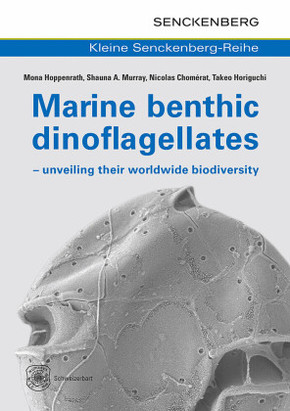
Marine benthic dinoflagellates - unveiling their worldwide biodiversity
| Verlag | Schweizerbart'sche Verlagsbuchhandlung |
| Auflage | 2014 |
| Seiten | 276 |
| Format | 14,8 x 21,0 x 1,9 cm |
| Gewicht | 600 g |
| Artikeltyp | Englisches Buch |
| Reihe | Kleine Senckenberg-Reihe 54 |
| ISBN-10 | 351061402X |
| EAN | 9783510614028 |
| Bestell-Nr | 51061402A |
This publication presents the first summary of our knowledge of benthic dinoflagellate species. Dinoflagellates are important primary producers and symbionts, but, at the same time, also consumers and parasites. Species compositions of benthic habitats are quite distinct from those of planktonic habitats. Less than 10% of the approximately 2000 described extant dinoflagellate species appear to be benthic. They occur in different types of habitats (chapter II) and their morphology, their behavior, and some of their life cycles (chapter VI) seem to be well adapted to the benthic lifestyle. Information on their geographic distribution is still very limited and is compiled herein (chapter V). The study of harmful benthic dinoflagellates started in the late 1970s when it was suspected that a benthic species, later named Gambierdiscus toxicus, was responsible for ciguatera fish poisoning, a type of human poisoning linked to the consumption of certain species of tropical reef fish. As the number of ciguatera fish poisoning incidents increases, and the distribution of toxin producing benthic taxa seems to be expanding, detailed understanding of the species diversity and the ability to accurately identify them is becoming increasingly important (chapter VII). Dinoflagellate classification is currently undergoing changes and far from being settled, as new species and genera are discovered and systematic entities are rearranged. Many benthic dinoflagellate genera have unusual morphologies and appear to be only remotely related to known planktonic taxa, so that molecular phylogenetic analyses frequently show little statistical support for any relationship (chapter IV). Benthic species display unique thecal plate arrangements compared to planktonic species, e.g. Adenoides, Amphidiniella, Cabra, Planodinium, Sabulodinium, Rhinodinium (chapter III). Therefore, no classification on higher rank levels (e .g. family, order) was used throughout this book. Genera (and species within a genus) are presented in alphabetical order. The book presents the first comprehensive identification help for benthic dinoflagellates. At the same time it aims to lend support in order to improve monitoring efforts worldwide. About 190 species in 45 genera are presented in detail, illustrated with more than 200 color images, approximately 150 scanning electron micrographs, and more than 250 drawings.
